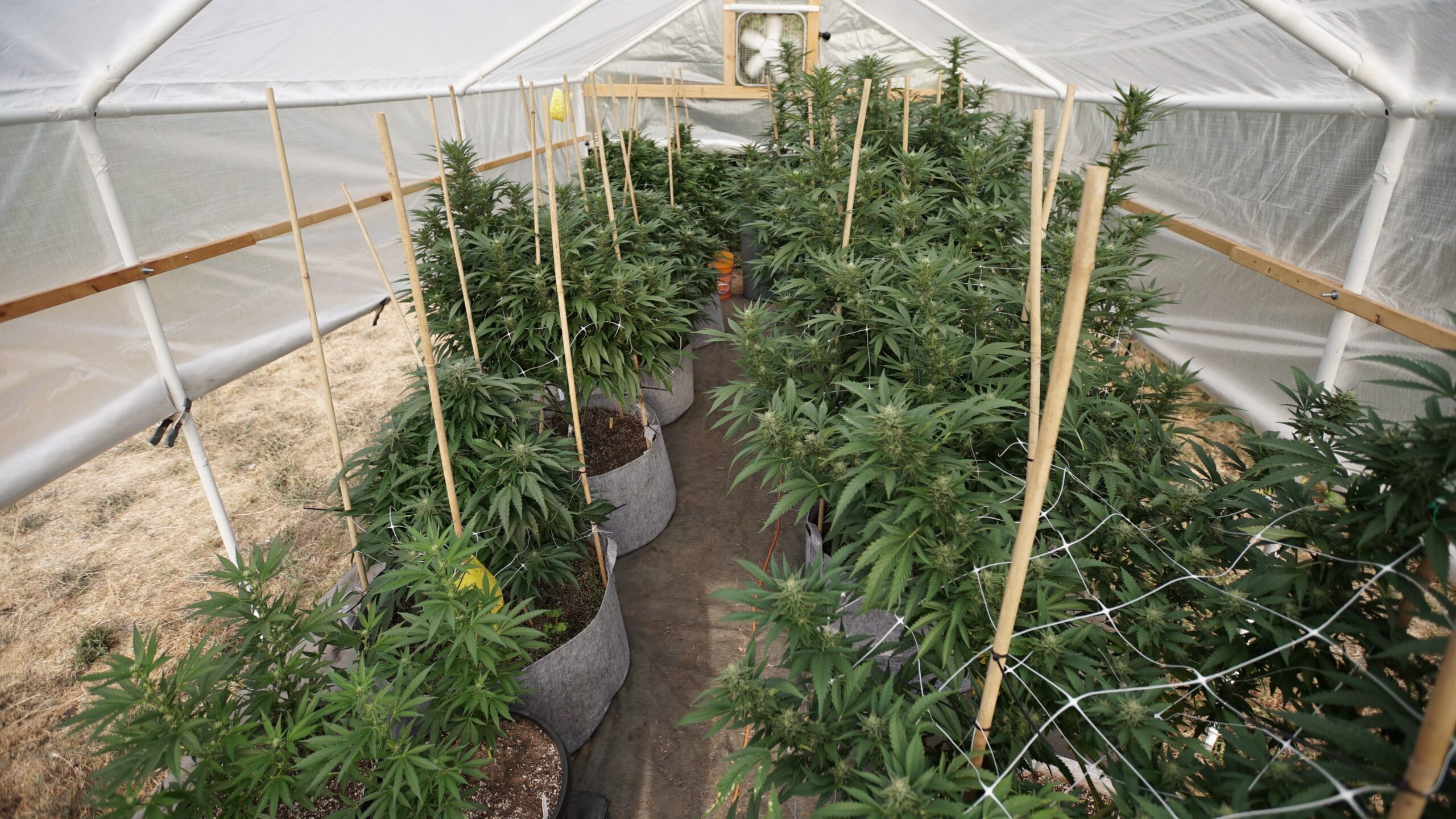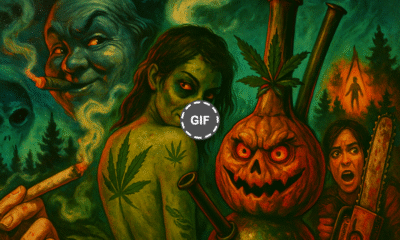featured
Michigan Lawmakers Consider Bills To Change Legal Marijuana Possession Limits And Alter Industry Disciplinary Rules
Published
2 hours agoon

Michigan has “become, in a lot of ways, sort of a central location for illicit operations, because the penalties for illicit activity are so low here.”
By Ben Solis, Michigan Advance
Four marijuana-related bills were up for consideration before a House panel on Thursday, with one aiming to upend rules on the legal amount of regulated marijuana a person is allowed to possess, both in plant and concentrate form.
Members of the House Regulatory Reform Committee discussed but did not amend or advance House Bill House 5104, Bill 5105, House Bill 5106 and House Bill 5107.
Derek Sova, a policy and legislative assistant for the Cannabis Regulatory Agency, told the committee previously that Michigan’s legal marijuana industry faced several challenges, and that two of those big hurdles were large illicit grow operations and the agency’s inability to go after bad actors because their licenses had expired.
The series of bills before the committee would address those concerns.
House Bill 5105 and House Bill 5107 are sponsored by state Reps. Pauline Wendzel (R-Watervliet) and Mike Hoadley (R-Au Gres), respectively. The bills would in tandem create new penalties for cultivating, delivering and processing black market marijuana, but also change the amount of marijuana a person is legally allowed to possess in plant and concentrate form.
The bills are tie-barred together, meaning both would have to jointly clear the Legislature and be signed by the governor to become law.
Under Wendzel’s bill, a person would be guilty of a misdemeanor if they possess between 10 and 25 kilograms, or between 50 and 100 plants, or between one and 2.5 kilograms of marijuana concentrate. The penalty would change to up to one year in jail or a $20,000 fine, or both.
Keeping between 25 and 125 kilograms, or between 100 and 500 plants, or between 2.5 and 12.5 kilograms of marijuana concentrate would become a felony punishable by two years in prison or a $500,000 fine, or both.
It would also be a felony offense to:
- Keep between 125 and 250 kilograms, or between 500 and 1,000 plants, or between 12.5 and 25 kilograms. That could net a person four years in prison or a $2 million fine or both; and
- Keep 250 kilograms or more, or 1,000 plants or more, or 25 kilograms or more of marijuana concentrate. The punishment there would be up to 10 years in prison or a $10 million fine, or both.
Sponsored by state Rep. Kristian Grant (D-Grand Rapids), House Bill 5104 would allow the Cannabis Regulatory Agency to sanction a person even if they are no longer a licensee or if they are no longer operating a marijuana facility.
At present, the Medical Marihuana Facilities Licensing Act holds that the expiration of a state-issued license terminates the authority of the agency to impose sanctions. The bill from Grant would retain that position but would add that the authority to impose sanctions would continue if there was already a pending action against a former licensee or facility operator.
House Bill 5106, sponsored by state Rep. Jerry Neyer (R-Shepherd), would amend the state’s Regulation and Taxation of Marihuana Act to similarly address disciplinary action on recreational licenses. The bill would let the agency summarily suspend a license if the licensee’s conduct poses a risk to the health, safety or welfare of the public.
Much like House Bill 5104, Neyer’s legislation would also give the agency authority to take disciplinary action against a person who no longer holds a license or if their license has recently expired.
The risks that could lead to license suspension or discipline, as outlined in the bill, include possessing marijuana from a source that cannot be determined, keeping marijuana stashes obtained in violation of the act, obstructing an agency investigation, and failing to provide the agency with required records.
Neyer’s bill affects growers, processors, retailers, microbusinesses, safety compliance facilities and secure transporters.
State Rep. Emily Dievendorf (D-Lansing) said they were concerned about upticks in enforcement given that some industry folk were previously on the negative end of marijuana enforcement when it was illegal in Michigan. She questioned whether it was right to increase enforcement when the state was actively beginning to tax marijuana sales at a higher rate, which some have warned will ultimately push consumers to the black market.
Sova said that the point of the package was to support the licensed industry, as much as possible, especially those following the rules.
“That’s the purpose of giving us the greater enforcement authority over the bad actors in the licensed space who are cheating, who are undermining the folks who are trying to do it the right way,” Sova said. “This has been an issue, I believe, in communities where you’ve had a lot of these large illicit outdoor growers. You’re talking sometimes thousands or tens of thousands of plants that, the way the statutes are set up right now, there’s really no disincentive to continue doing that.”
Sova added that Michigan has “become, in a lot of ways, sort of a central location for illicit operations, because the penalties for illicit activity are so low here.”
State Rep. Joseph Aragona (R-Clinton Township), the committee’s chair, said he agreed with Dievendorf.
“The 24 percent tax was difficult,” he said. “We obviously did not want to do in the House, but this could definitely help those legal growers who are going to be paying it, because, if I’m mistaken, the black market won’t be paying that tax.”
Sova said that was certainly the intention of the pending legislation.
Hoadley also testified along with Iosco County Prosecutor Jim Bacarella and Branch County Prosecutor Zach Stempien, both of whom supported the legislation and expressed concern for those working in the industry. Some of that concern had to deal with the exploitation of migrant workers or foreign nationals, which were issues brought up by the prosecutors during testimony.
This story was first published by Michigan Advance.
Photo courtesy of Chris Wallis // Side Pocket Images.

Author: mscannabiz.com
MScannaBIZ for all you Mississippi Cannabis News and Information.
You may like
-


What Levi Strauss Can Teach Us About Craft and Cannabis
-


Bad Stoner Horror: The 10 Worst-Rated 420 Scary Movies
-


Vee the Traveling Cannabis Writer Unveils First Book in Cannabis Legacy Series – Ganjapreneur
-


[Video] G Herbo: Snoop Rolled My Blunt and Let Me Hit It, Smoking A Zip a Day, Chicago Munchies (Weird) and What’s Next
-


Marijuana Companies Ask U.S. Supreme Court To Take Up Case Challenging Constitutionality Of Federal Prohibition
-


The Odds Of The Feds Making A 2025 Cannabis Change
featured
What Levi Strauss Can Teach Us About Craft and Cannabis
Published
1 hour agoon
October 25, 2025
Entirely by chance, my father is buried just a few rows away from Levi Strauss, the man whose name is synonymous with denim and one of the most enduring clothing brands in American history.
For decades, whenever I went to the cemetery just outside San Francisco, I’d quickly pause to say hello to Mr. Strauss. And I always made it a point to tell him, “Thanks for the jeans.” It was kind of our thing.
Aside from a few stray words, I seldom speak out loud if I’m by myself, even when I’m hanging out with dead people. That’s why it surprised me when, one afternoon, my relationship with Mr. Strauss took an admittedly unusual turn.
Instead of a pause on my way in, I made a hard stop. I’d just been through a difficult stretch in my work as a product developer and was reeling. Seeing that I had the ear of a fellow inventor, I decided to open up to Mr. Strauss that day, and I could tell he was a good listener. It was the first real conversation we’d ever had, and it taught me more than I could have imagined. I never talk shop when I’m visiting my father—he was a podiatrist.
Taking a moment to read the room before discussing my business in polite company, I looked around the mausoleum to where Mr. Strauss now resides and found the information I was searching for etched in white marble: LEVI STRAUSS — BORN 1829 – DIED 1902.
Seeing that he wouldn’t have even known about the earthquake—let alone all of the political matters I was about to discuss—I realized there was a lot I should catch him up on first.

Hemp Before the Fall
I told Mr. Strauss that I worked in the cannabis industry—except that he would know it as hemp. It was a crop grown everywhere in the nation, commonly used to make durable fabrics, canvas, and rope. Hemp had been indispensable during the Gold Rush, especially in a maritime city like San Francisco, as its fibers could withstand saltwater without breaking down.
But in 1906, shortly after Mr. Strauss passed away, a new law required medicines to disclose their ingredients on labels, and hemp was suddenly listed alongside narcotics like opiates and cocaine. Over time, they were clumsily lumped into the same category and wrongly classified as poison. But it isn’t a poison. And to this day, not a single death has ever been reported from its use.
Even so, U.S. cannabis prohibition officially took root in 1937—a chapter of history rarely acknowledged, and one I knew would interest Mr. Strauss especially. I explained how hemp had been rebranded as “marihuana” in the 1930s, a slang word in Spanish intentionally chosen to make the plant sound foreign and threatening rather than a simple, one-syllable crop. Behind the scenes, however, that “threat” wasn’t cultural—it was personal.
The Earliest Days of the Drug War
Publisher William Randolph Hearst, whom Mr. Strauss surely would have known personally, had a substantial investment in the timber industry, which supplied wood pulp for his newspapers. But hemp-processing equipment was quickly advancing to make the crop a cheaper, stronger, and more sustainable alternative to wood, which put Hearst’s empire at risk.
With an agenda to eliminate the competition, Hearst’s newspapers ran sensational headlines designed to stoke fear and turn public opinion against the plant.
In a coordinated media campaign with the newly formed U.S. Bureau of Narcotics, hemp was portrayed as a dangerous drug tied to crime and immigration—deemed a direct threat to the nation.
In 1937, the Marihuana Tax Act made hemp illegal in the United States, setting a global precedent and essentially wiping out a crop that could have supplied countless innovations over the years—including compostable plastics, biofuel, and important medicines—all because one man wanted to safeguard his timber business. Imagine that.
Strangest of all, those federal restrictions remain unchanged in the United States, nearly a century later.
Today, cannabis continues to be listed alongside heroin as a Schedule I drug—the most dangerous category under federal law.
By contrast, cocaine and methamphetamines are Schedule II, as is fentanyl, which killed nearly 50,000 Americans last year. In other words, cocaine and fentanyl are legally considered less dangerous than cannabis, despite zero deaths. And that’s a blatant contradiction I can’t unsee.
But the narrative wasn’t new to me; it echoed the 1970s and ’80s, when I was growing up and cannabis was treated like a weapon in America’s culture wars. The White House taught everyone to “Just Say No,” while police officers came into 75% of the nation’s classrooms through the D.A.R.E. program to warn us that marijuana was the gateway to everything evil and that anyone who used it was destined to ruin their lives.
That made things confusing when I accidentally caught my mother smoking pot—and it broke my heart. I couldn’t speak a word to her for weeks.
At the same time, alcohol not only got a free pass but was celebrated at every turn. Looking back now, the most destructive and dangerous things I’ve witnessed didn’t come from cannabis but from people who drank too much alcohol. And I could no longer unsee that one, either.


Fifty States, a Thousand Contradictions
I told Mr. Strauss how, eventually, states and counties began creating their own laws. More than 40 states and territories have legalized medical cannabis, and nearly half allow recreational use, too. But it’s not as straightforward as it sounds.
California was the first state to legalize medical use in 1996 and added recreational use later, yet 53% of its jurisdictions still ban any type of cannabis business.
In New Orleans, cannabis is sold from what look like ice-cream trucks, because only mobile dispensaries are permitted there, but not brick-and-mortar ones.
And in our nation’s capital, Washington, D.C., the rules are especially odd: dispensaries abound, but buying and selling is still illegal, so it’s given away as a “free gift.” Buy a $50 lighter and choose your cannabis gift; spend $75 for the same lighter and get a top-shelf selection.
Despite the patchwork of laws, legal cannabis still felt revolutionary. For the first time, I knew in advance which effects I’d experience with each plant strain and began integrating it into my yoga and meditation practice to reset my nervous system from PTSD. It did wonders for me, and I’m truly grateful to have lawful access.

Prospectors and Pickaxes
I explained how those experiences—and even Mr. Strauss himself—had inspired me to bring my specialized skill set to the supply chain. “You see,” I said, “I studied the old Gold Rush to understand the new one and was reminded that the people who prospered most weren’t the miners, but the merchants who sold them pickaxes, shovels, and jeans. And after years of saying hello to you, the point finally landed—so that’s where I decided to focus my attention. I would let someone else deal with the weird regulations. I’m going after the supply chain where I can do business anywhere in the world without restrictions.”
It was then that I decided to ask Mr. Strauss for some business advice. How had he done it—and found his way during the first Gold Rush? And what would he do moving forward if he were standing in my very same boots?
But as I tried to imagine his response, it suddenly hit me: I had no idea what Levi Strauss even looked like. I’d been saying hi for twenty years, but I only knew Levi Strauss as a label, not as an actual human being. I apologized for my manners and promised him I would fix that.
I bought the only biography ever written about Levi Strauss, expertly crafted by historian Lynne Downey. Most of his records had been destroyed in the fires after the earthquake, so the book itself was a remarkable feat and an excellent read. But I was in for another surprise.
Levi Strauss was eighteen when he immigrated from Buttenheim, Bavaria, to New York to join his brothers in their dry-goods trade. In 1853, he was sent west to run the San Francisco division of the family business. And then my jaw dropped as I learned the rest.


The Stitch That Changed the World
Levi Strauss did not invent jeans. He was the man who knew how to mass-produce them. The real MVP and creator of riveted pants was somebody else entirely, and I’d never heard his name.
Jacob W. Davis, or J.W. as he liked to be called, was a tailor from Riga, Latvia, who immigrated to the United States in 1854 at the age of twenty-three. He traveled across the U.S. and Canada looking for work, filing patents along the way for a canal steamboat, an ironing board, and a button that fastened with a screw, but nothing took.
Eventually, he returned to tailoring and opened a shop in Reno. In 1871, a woman came in and asked him to make pants for her husband—but she had a special request: make them extra strong.
Until then, pockets often tore off when people carried tools, and nobody thought twice about it. But J.W. had been sewing horse blankets and had some rivets nearby, so he had the notion to use them as reinforcements. Pockets never fell off again.
The pants were a huge hit, but after a year, he couldn’t keep up with demand, and others began to copy the idea. He applied for a patent, but it was rejected, likely due to his poor English. He wrote a letter to Mr. Strauss, who may have been his fabric supplier, seeking financial backing. They became partners: Mr. Strauss scaled distribution while J.W. ran production. He also invented the orange stitch design that became their signature look. They each stayed at the company for the rest of their lives.
Both men were extraordinary in their own right. Strauss became thoughtfully engaged in politics, using his influence to push for the kind of civic reform that would help to build an early San Francisco. And J.W. helped me realize that I was Jacob Davis in the equation in need of a Levi Strauss. Because in cannabis, where policies can literally shift overnight, timing is often the only real difference between progress and prohibition.
While Mr. Strauss never married or had children, J.W.’s son and grandson went on to found the Ben Davis Clothing Company in 1935, a San Francisco workwear brand still in operation today.

Ghosts in the Fabric
Recently, as the summer fog rolled into San Francisco, I ordered some Ben Davis beanies to stay warm and needed to spend another $3 to hit free shipping. I spotted something called “suspender buttons” for $4 and bought them. When the package arrived, I poured out the contents of a small bag into my palm, and I could hardly believe my eyes.
I was holding buttons that fasten with a screw. J.W.’s failed invention had managed to time-travel more than 150 years and land in my lap, demonstrating firsthand how far an idea can go once it’s been put into the right pair of hands.
It’s a powerful insight that applies to the plant, too. This is the moment when the story of cannabis gets rewritten, and finally course-corrects after a very long and most regrettable misunderstanding. Pairing ideas with action today will steer the innovations that matter tomorrow, ensuring that cannabis finds its way back to its rightful place in history. Because healing isn’t just the goal—it’s the plant’s legacy.
As luck would have it, Jacob W. Davis resides at the same cemetery as my father and Mr. Strauss, so I visit JW now, too. I leave a stone on his grave, and I always make a point to tell him, “Thanks for the jeans.”
All images courtesy of the author, LL St. John with featured image by Banjo Schmarino.
This article is from an external, unpaid contributor. It does not represent High Times’ reporting and has not been edited for content or accuracy.

Author: mscannabiz.com
MScannaBIZ for all you Mississippi Cannabis News and Information.
featured
Bad Stoner Horror: The 10 Worst-Rated 420 Scary Movies
Published
13 hours agoon
October 24, 2025
The horror genre and weed culture have crossed paths plenty of times, giving birth to a quirky (and often laced with humor) subgenre known as stoner horror. But not all of these productions hit the mark as hard as the great masterpiece Cabin In the Woods (2011), the hilarious This Is The End (2013), or even the pretty–decent Idle Hands (1999). Some have earned the label of the “worst stoner horror flicks” thanks to their ridiculous plots, low-budget special effects, and questionable acting.
Among the most notorious examples are Evil Bong (2006), Bong of the Dead (2011), and Pot Zombies (2005). While these films lack solid execution, they’ve managed to gain cult status among B-movie horror fans thanks to their over-the-top, often comical approach.
So, are they worth watching? Maybe, maybe not, but one thing’s for sure: when a film goes from bad to downright terrible, it can still make for some pretty good entertainment.
Here’s your list (watch out! Spoilers ahead).
Ranked from best to worst: 10 weed-infused horror movies
10 – Bong of the Living Dead (2017)
This horror-comedy follows a group of stoner friends who see their dream of surviving a zombie apocalypse come true. At first, it seems exciting, but they soon realize the apocalypse isn’t nearly as fun as they imagined.
The movie blends classic stoner humor with a heavy dose of zombie gore. With subtle recalls to Shaun of the Dead, it works as a parody of the zombie genre made on a shoestring budget, but standing out for its creativity and style.
9 – The Tripper (2006)
Directed by David Arquette and starring Courteney Cox (Friends), this film mixes horror with political satire. A group of young people head to a music festival in the woods, only to be hunted by a serial killer obsessed with Ronald Reagan. Serving as a critique of 1980s conservative politics, the movie stands out for its bloody, offbeat approach.
8 – Trim Season (2024)
In this horror thriller, a group of seasonal workers venture onto a remote weed farm in California, only to discover something far more sinister lurking among the plants. The film blends rural horror with a critique of labor exploitation.
7 – Hansel & Gretel Get Baked (2013)
This horror-comedy puts a modern twist on the classic tale of Hansel and Gretel. When Gretel discovers a powerful strain called Black Forest, she and her brother find themselves embroiled in a bloody adventure involving a modern-day witch, played by Lara Flynn Boyle (Twin Peaks). With irreverent humor and horror effects, this film is a bizarre and modern take on the classic.
6 – Evil Bong (2006)
A horror-comedy starring cannabis icon Tommy Chong, where a group of friends buys a mysterious bong that turns out to be possessed. After lighting up, they are transported to a hellish dimension where they must fight for their lives. The film is part of a series known for its absurd humor: its sequel, Evil Bong 420, has an even lower rating: a whooping 2.6/10 on IMDb.
5 – 4/20 Massacre (2018)
Five girlfriends decide to spend April 20th (4/20) camping in a national park, where they come across an illegal grow operation and are forced to fight to survive against a killer maniac. This film blends slasher horror with weed culture, offering both scares and references to stoner icons.
4 – Halloweed (2016)
Two brothers, one of them famous for being the son of a serial killer, move to a new town to escape their past. However, murder follows the family as they try to enjoy a quiet, pot-fueled life.
3 – Star Leaf (2015)
In this science fiction film, a group of friends discovers an alien cannabis plant in the forest that can connect humans to other dimensions. However, smoking from it attracts the attention of extraterrestrial forces.
2 – Bong of the Dead (2011)
Not to be confused with Bong of the Living Dead, in this low-budget horror comedy, two stoner friends survive a zombie apocalypse using weed as their primary defense tool. It’s an irreverent, low-budget take that parodies the zombie genre.
1 – Pot Zombies (2005)
In this cult horror film, people who smoke contaminated pot turn into bloodthirsty zombies. It’s a low-budget production with a B-movie aesthetic that has become a classic within the stoner horror subgenre.

Author: mscannabiz.com
MScannaBIZ for all you Mississippi Cannabis News and Information.
featured
Vee the Traveling Cannabis Writer Unveils First Book in Cannabis Legacy Series – Ganjapreneur
Published
14 hours agoon
October 24, 2025
Acclaimed cannabis journalist and documentarian Veronica “Vee” Castillo has released the first installment of her series The Traveling Cannabis Writer’s Guide to America’s Hidden Gems. Part 1 of the series, dubbed The 30,000-Foot View, is an impactful collection of notes from the road bringing together more than six years of on-the-ground reporting from across the United States, and highlighting the voices, businesses, and cultural movements often overlooked by mainstream media coverage.
Castillo has built a reputation as one of the most trusted grassroots storytellers in cannabis media. Through 200+ published articles across more than 20 publications, she has documented the cannabis movement not from behind a desk, but face-to-face with craft cultivators, equity entrepreneurs, reform advocates, and plant medicine practitioners operating within the legacy of prohibition. From small farming towns to inner-city collectives, Castillo’s work places community and lived experience at the center of the cannabis narrative.


About the Book
Part memoir, part documentary journalism, and part social history, The 30,000-Foot View explores:
- The origins of a journey — Castillo’s decision to leave her home in Ohio in 2018 and travel the country to learn about plant medicine after cannabis helped her overcome debilitating migraines.
- Women shaping cannabis innovation — Insightful profiles of women—primarily Black, Brown, and Latina entrepreneurs—building purpose-driven brands in a system not built for them.
- Culture and connection — A rare look at cannabis’ cultural roots across Puerto Rico, Florida, Chicago, and beyond, where food, music, tradition, and plant medicine intersect.
- Advocacy on tour — Behind-the-scenes documentation of educational, business, and policy tours that connected grassroots operators and advanced equity conversations nationwide.
- The economics of survival — A frank examination of taxes, regulation, and the true cost of building an equitable cannabis industry under ongoing systemic pressure.
A Record of Cannabis Progress, as Shared by the People in It
With state-level drug policy reforms sweeping the country and consolidation reshaping the cannabis business landscape, Castillo believes it is urgent to preserve the legacy of the movement before it becomes distorted.
“Corporate cannabis didn’t build this industry,” Castillo writes. “Communities did. Healers did. Freedom fighters did. Farmers did. People harmed by the War on Drugs did. These are their stories, and they deserve permanence.”
In contrast to most cannabis industry analysis available in book form, Castillo’s work is lived, personal, and fiercely human. She brings readers into farms, family kitchens, hemp mansions, trap-adjacent clinics, cross-country tour vans, and policy meetings alike. The 30,000 Foot View is a historical archive in motion and a rallying call for equity-centered growth in cannabis.
Availability
The 30,000 Foot View is now available on Kindle. For media inquiries, partnership opportunities, and speaking engagements, please reach out to: Veetravelingvegcannawriter@gmail.com

Author: mscannabiz.com
MScannaBIZ for all you Mississippi Cannabis News and Information.

What Levi Strauss Can Teach Us About Craft and Cannabis

Michigan Lawmakers Consider Bills To Change Legal Marijuana Possession Limits And Alter Industry Disciplinary Rules

Bad Stoner Horror: The 10 Worst-Rated 420 Scary Movies

Vee the Traveling Cannabis Writer Unveils First Book in Cannabis Legacy Series – Ganjapreneur

[Video] G Herbo: Snoop Rolled My Blunt and Let Me Hit It, Smoking A Zip a Day, Chicago Munchies (Weird) and What’s Next

Marijuana Companies Ask U.S. Supreme Court To Take Up Case Challenging Constitutionality Of Federal Prohibition

The Odds Of The Feds Making A 2025 Cannabis Change

The Epic High Times Cannabis Cup Journey, From Amsterdam to the Empire State

GOP Senator Pushes To Study—Rather Than Ban—Hemp Products, As State Attorneys General Call For THC Prohibition

Happy International Champagne Day – The Fresh Toast

Maryland Police Want To Watch You Smoke Weed: Free Munchies and Ride Home Included

More Americans Now Use Marijuana Than Smoke Cigarettes, New Study Shows

Unexpected Pleasures of Weed: The Strain That Turned My Husband Into a Clean Freak

Texas Officials Adopt Rules To Expand Number Of Medical Marijuana Dispensaries In the State

Cannabis Ventures, Start-Up Best Practices, and Ways to Compete

Older Adults Increasingly Identify as Cannabis Consumers

Kentucky Governor Touts Surge In Medical Marijuana Patient And Business Approvals As State Prepares For Program Launch

SCOTUS cannabis & guns case gets delay request (Newsletter: October 24, 2025)

Ohio House Passes Cannabis, Hemp Bill Resulting From ‘Venn Diagram From Hell’

What To Know About Cannabis And A Brain Aneurysm

MariMed to Expand Brand Distribution to New York

Time for a Cannabis Reboot: Local Roots, Fair Markets, Real Change

Ohio Health Agency Grants $400,000 To Fund Psychedelics Education And Training For First Responders, Doctors And More

Curio Wellness Acquires 4 Greenlight Dispensaries in Missouri

Alert: Department of Cannabis Control updates data dashboards with full data for 2023

Connecticut Appoints The US’s First Cannabis Ombudsperson – Yes there is a pun in there and I’m Sure Erin Kirk Is Going To Hear It More Than Once!

5 best CBD creams of 2024 by Leafly

Recreational cannabis on ballot for third time in South Dakota

EU initiative begins bid to open access to psychedelic therapies
New Study Analyzes the Effects of THCV, CBD on Weight Loss

Free delta-9 gummies from Bay Smokes

5 best autoflower seed banks of 2024 by Leafly

Discover New York’s dankest cannabis brands [September 2024]

Press Release: CANNRA Calls for Farm Bill to Clarify Existing State Authority to Regulate Hemp Products

May 2024 Leafly HighLight: Pink Runtz strain

5 best THC drinks of 2024 by Leafly

Local medical cannabis dispensary reacts to MSDH pulling Rapid Analytics License – WLBT

6 best CBD gummies of 2024 by Leafly

Curaleaf Start Process Of Getting Their Claws Into The UK’s National Health System – With Former MP (Resigned Today 30/5/24) As The Front Man

Horn Lake denies cannabis dispensary request to allow sale of drug paraphernalia and Sunday sales | News

5 best delta-9 THC gummies of 2024 by Leafly

The Daily Hit: October 2, 2024

Mississippi city official pleads guilty to selling fake CBD products

Nevada CCB to Accept Applications for Cannabis Establishments in White Pine County – “Only one cultivation and one production license will be awarded in White Pine County”

5 best THCA flower of 2024 by Leafly

Weekly Update: Monday, May 13, 2024 including, New Guide for Renewals & May Board meeting application deadline

6 best hemp pre-rolls of 2024 by Leafly

PRESS RELEASE : Justice Department Submits Proposed Regulation to Reschedule Marijuana
Trending
-

 California Cannabis Updates1 year ago
California Cannabis Updates1 year agoAlert: Department of Cannabis Control updates data dashboards with full data for 2023
-

 Breaking News1 year ago
Breaking News1 year agoConnecticut Appoints The US’s First Cannabis Ombudsperson – Yes there is a pun in there and I’m Sure Erin Kirk Is Going To Hear It More Than Once!
-

 best list1 year ago
best list1 year ago5 best CBD creams of 2024 by Leafly
-

 Business1 year ago
Business1 year agoRecreational cannabis on ballot for third time in South Dakota
-

 Business1 year ago
Business1 year agoEU initiative begins bid to open access to psychedelic therapies
-

 cbd1 year ago
cbd1 year agoNew Study Analyzes the Effects of THCV, CBD on Weight Loss
-

 Bay Smokes1 year ago
Bay Smokes1 year agoFree delta-9 gummies from Bay Smokes
-

 autoflower seeds1 year ago
autoflower seeds1 year ago5 best autoflower seed banks of 2024 by Leafly

